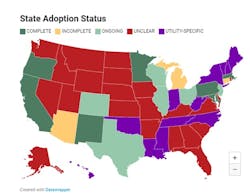Smart Inverter States: New Map Shows Progress of IEEE 1547-2018 Adoption
Seven U.S. states have completed adoption of a key industry technical standard for how distributed energy resources, such as microgrids, are connected and interact with the main grid and end user loads.
The Institute of Electrical and Electronics Engineers (IEEE) several years ago established its IEEE 1547-2018 standard on interconnection requirements for smart inverters. This type of equipment makes it safer for the grid to accommodate higher levels of sometimes intermittent renewable energy, which itself can be deployed to support grid functions.
Recently, the industry non-profit advocacy group Interstate Renewable Energy Council (IREC) released its IEEE 1547-2018 Adoption Tracker Map to indicate the status across states and system operators nationwide and in parts of Canada. In those states, the utilities and state regulators have selected and announced deadline dates for requiring certification of inverters to the IEEE standard.
The IREC map shows that Maryland, Massachusetts, Pennsylvania, Minnesota, New Mexico, Oregon and California have completed the smart inverter standard implementation process both by state energy regulators and utilities.
Grid operators and utilities in six more states are on the way to ensuring adoption of the smart inverter standard. Those states considered “ongoing” in their adoption IEEE 1547-2018 process are Texas, Colorado, Illinois, Wisconsin, Ohio and New Jersey.
States such as Oklahoma, Louisiana, Mississippi, Tennessee, New York and Maine, among others, are home to utilities which are electing to adopt the smart inverter standard. In those states, however, the regulatory commissions have yet to perform an official adoption process.
At least 20 states, mostly in the northern Rocky Mountains and southeastern U.S. regions, are considered “unclear” in their processes. Neither the state commissions nor utilities have commenced any formal adoption processes for IEEE 1547-2018 certification.
The IREC admitted that information is unclear with respect to some utilities as it is still gathering information.
Independent system operators of regional transmission organizations which have completed the smart inverter standardization adoption include the Alberta System Operator in Canada and PJM Interconnection which manages much of the grid throughout Pennsylvania, Ohio, Virginia, Maryland and New Jersey.
The need is immediate and the challenge growing larger
In 2024’s first quarter alone, close to 5 GW (4,557 MW) of solar capacity was installed in the U.S., according to reports by the American Clean Power Association. Last year, an all-time high of more than 32 GW of solar generating capacity was added, according to the Solar Energy Industries Association and research firm Wood Mackenzie.
Stable grid operation relies on manageable frequency levels, while solar and wind are intermittent resources. Smart inverters convert direct current output of solar panels into the alternating current which is used in homes and businesses, while also offering grid support functions such as voltage regulation, frequency support and voltage ride-through.
The future of DERs includes the potential scaling up of interaction between microgrids and the main grid. These growing interactions can include dispatching of virtual power plants, which use intelligent control systems and bidirectional technologies to aggregate distributed energy generation and re-allocate it when and were needed at times of peak demand.
An interconnection backlog is growing as system operators and utilities determine how to integrate an exponentially rising level of DERs within the overall grid. IEEE’s 1547-2018 seeks to aid in accommodating and integrating this high penetration of renewables and requires voltage support from the DERs.
The Microgrid Knowledge 2024 Conference was last month in Baltimore, Maryland. Next year’s MGK 2025 will be April 15-17 in Dallas.
About the Author
Rod Walton, Microgrid Knowledge Head of Content
Managing Editor
For Microgrid Knowledge editorial inquiries, please contact Managing Editor Rod Walton at [email protected].
I’ve spent the last 15 years covering the energy industry as a newspaper and trade journalist. I was an energy writer and business editor at the Tulsa World before moving to business-to-business media at PennWell Publishing, which later became Clarion Events, where I covered the electric power industry. I joined Endeavor Business Media in November 2021 to help launch EnergyTech, one of the company’s newest media brands. I joined Microgrid Knowledge in July 2023.
I earned my Bachelors degree in journalism from the University of Oklahoma. My career stops include the Moore American, Bartlesville Examiner-Enterprise, Wagoner Tribune and Tulsa World, all in Oklahoma . I have been married to Laura for the past 33-plus years and we have four children and one adorable granddaughter. We want the energy transition to make their lives better in the future.
Microgrid Knowledge and EnergyTech are focused on the mission critical and large-scale energy users and their sustainability and resiliency goals. These include the commercial and industrial sectors, as well as the military, universities, data centers and microgrids. The C&I sectors together account for close to 30 percent of greenhouse gas emissions in the U.S.
Many large-scale energy users such as Fortune 500 companies, and mission-critical users such as military bases, universities, healthcare facilities, public safety and data centers, shifting their energy priorities to reach net-zero carbon goals within the coming decades. These include plans for renewable energy power purchase agreements, but also on-site resiliency projects such as microgrids, combined heat and power, rooftop solar, energy storage, digitalization and building efficiency upgrades.


